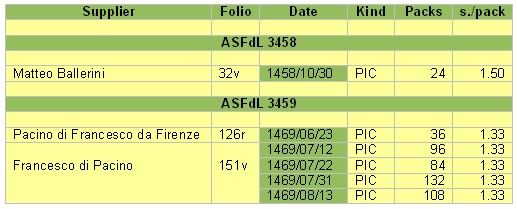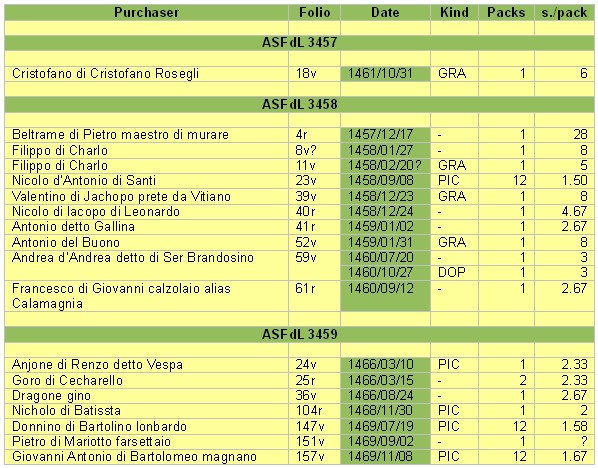Introduction
The new evidence reported here comes again from the Fraternita dei Laici in Arezzo;(1) its valuable Archivio Storico (ASFdL) contains many account books of local traders, in its Testatori section.(2) The retailer under examination, Stefano Minucci, is again a mercer and silk-dealer; in this case, however, we are already in the second half of the 15th century.
In some of the titles of his books, Stefano Minucci adds the label Ser to his father’s name Giovanni, thus probably a notary. Using this information, I could check the corresponding evidence in Catasto. Unfortunately, Stefano appears not to have yet born in 1429, the year of that document.(3) Only his parents are present, Giovanni indeed as a notary, 33 years old, and his wife Nofria, only 14 by then. Their taxable income was fairly small, L. 137 s.5, but they owned several lots of land.
In the absence of any news about Stefano and his family in later years, the location of his shop may be of interest: I remember having read somewhere – if this was not a mirage, as possible from the window itself of the reading room of the Fraternita - that it was directly placed in Piazza Grande, the main square of the town, where a market was regularly held.
Stefano’s account books
Four books by Stefano di Giovanni have been kept in the ASFdL. In the Inventory,(2) they are distinguished in two groups: a first book,(4) “Libro di debitori e creditori”, a thick ledger only partially compiled, followed by a set of three smaller books, indicated with the cumulative name of “Giornali di debitori e creditori e ricordanze”.(5)(6)(7)
The last books were marked by the mercer himself as A, B, and C, respectively. Only in the last one he added the name of “Libro C delle recordanze”, whereas in the previous ones he had indicated as contents “debitori di bottega” for A, and “tutti coloro che m’avaranno a dare o avere” for B. There is actually no substantial difference among these three books, except the richness of their detail. Books A and B cover about the same time interval of seven-eight years, but A has 83 folios, and B 204 ones; on the other hand, book C covers thirteen years in 114 folios.
In the last book, Stefano changes the indication of his profession: Merciaio is still there, but together with this profession, he adds that of Setaiolo. We thus find another colleague of other retailers, who had recorded their trades of playing cards among sales of silks and other haberdashery.
Now, it is far from certain that any “merciaio-setaiolo” of the 15th century had a secondary trade of playing cards (and of course finding another case as fruitful as that of Lorenzo di Bartolo and Matteo di Zanobi(8) will not be simple), but I am inclined to consider all such retailers as possible candidates for having recorded some evidence of our interest.
Carte instead of Naibi
Much of the possible discussion on these new findings is reported together with their description below. There is however a preliminary point to comment on for all of these playing cards: we have to remark that the formerly common name of Naibi has completely disappeared here. At this point, we read everywhere the more modern term of Carte, a name that we may also find written for items different from playing cards, as it could not occur for Naibi.
To be exact, what we read is rather Charti; nevertheless, writing “cha” for “ca” was then a common usage, whereas I suppose that the final “i” was only written instead of “e” either as a kind of abbreviation, or for some other reason, yet however as a personal habit.
This is confirmed by the expression that we read of “di dare”, which clearly must be read as “de dare”, or “de’ dare”, as a shorter expression for “deve dare”, he must give.
Playing cards purchased
I have summarised in the Table below all the relevant records that I found in two of the four account books indicated above; in the first and fourth one, I could not detect any card purchase.
|
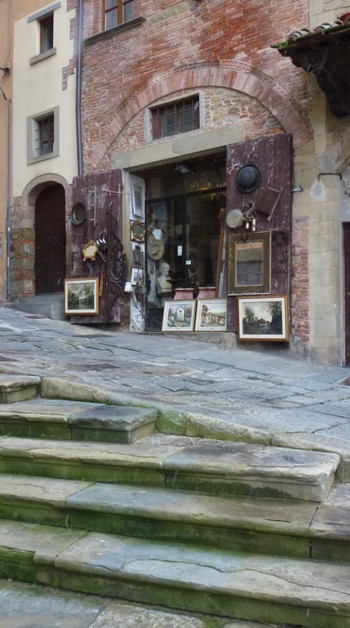
Shop in Arezzo, Piazza Grande
(where Minucci likely had his shop,
precise location is unknown)
|
|
|
We thus have two groups of purchases, separated by a more than ten years long interval. Actually, what looks extraordinary here is the rich supply in the 1469 summer.
Somewhat surprising and welcome among these records is already the card purchase of 1458, because it did not involve another mercer’s shop, be it located in Arezzo or in Florence. Stefano actually acquired a stock of two dozen packs of playing cards directly from a cardmaker, in particular Matteo Ballerini, with whom we already were rather familiar from similar trades discovered in Florentine account books.(8)
ASFdL 3458, f. 32v
|
Matteo Ballerini maestro di charte da giuchare de avere adì 30 dottobre [1458] s. trentassei i quali sono per doi dozzine di charte pichole per s. 18 dozzina........................................– L.1 s.16
Anne auto adì detto s. diciotto contante dei alla moglie...................................................................– L.- s.18
Anne auto adì 31 dottobre s. venti i quali sono per 2 libbre e mezzo di pelli montanine...................................................– L.1 s.-
|
There is nothing particularly amazing here, except maybe that the reckoning is not balanced. The payment occurred in two instalments, and the second time it was given in kind, with leathers; they are indicated as mountain hides - I am not familiar enough with these goods, but have seen that these “pelli montanine”, tanned and without coat, were frequently traded. In case, my curiosity is more unfulfilled in understanding whether and how these leathers could be used by Matteo in his own production of playing cards, or similar objects.
Rather unexpected is, in particular, to find Matteo in Arezzo: we did not find any indication for this provenance in the records of Florentine retailers. That he lived in Arezzo, or at least that he spent some time there, is confirmed by a previous record in the same book, on f. 27r: we find him on 12 September 1458 mentioned as “che fa i Naibi” while acquiring from Stefano a pair of clogs for s.1.
This origin from Arezzo may explain the ambiguity found in the Florentine records, in which Matteo was indicated either as Ballerini, or di Bartolommeo, or even di Francesco. (Under the Ballerini family name, I found no records in 1427 Catasto, either in Florence or in Arezzo.)
Significant may also be the name of Maestro, with which he was indicated. This title usually involved a team of apprentices working under a Maestro as their guide. In any case, to be acknowledged as a master, he had to cumulate years of experience and the production of masterpieces that could attest his ability in the specific field.
What is most amazing in this purchase, however, is yet another fact, which derives from the comparison of this trade with other supplies of cards that occurred at about the same time in Florence. Actually, when we verify these prices with those of Matteo’s cards sold in Florence to Lorenzo di Bartolo and Matteo di Zanobi(8) we find unexpected differences: whenever he sold his Naibi Piccoli in Florence, the price for a pack was s.3 or more; here, it is only s.1 d.6, just one half.
We must search for a possible explanation of so big a difference for, seemingly, the same cards. Of course in Florence there was more richness than in surrounding territories, and we can easily imagine that the local prices were generally higher; it is impossible however to suppose that the same cards could be sold in Arezzo at half price than in Florence. Whereas his Naibi sold in Florence were indicated as Doppi, here no indication is provided and probably they belonged to the Scempi kind,(9) but even this possible difference may not be sufficient to justify the price difference entirely.
Now, Naibi Piccoli of a price comparable with that seen in Arezzo were sold in Florence too; we can find a lot of them, if we search, for instance, within the sales of Niccolò di Calvello, instead of those of Matteo Ballerini.(9) We can thus suppose that Matteo produced low-cost cards too, as Niccolò did, without selling them however to the Florentine silk-dealers.
Considering the limited trade of playing cards, it is rather surprising to find cases, even if very sporadic ones, in which Stefano acquired many packs of them. The most typical such event occurred in the summer of 1459, when he acquired three dozen packs from a Florentine dealer and a surprising stock of no less than thirty-five dozens from Francesco di Pacino “sta ora alle porte d’Arezzo e di Firenze”, maybe the son of the previous seller.
It appears that these purchases occurred as instalments for paying some other goods that Stefano had sold before, but the fact that he accepted these objects in payment clearly shows that he could sell them on his turn.
Playing cards sold
After indicating the cards purchased by Stefano, we are left with the challenge to discover the corresponding sales, which I could only find recorded in a very few cases; in particular, part of such sales should also be found in book 3460, where I found none of them.
I have summarised in the Table below all the relevant records that I could find in these account books; they include sales of different playing cards, which I did not see recorded while purchased.
|
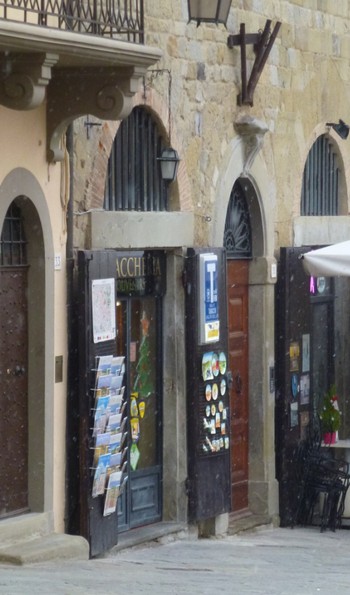
Shop in Arezzo, Piazza Grande
(where Minucci likely had his shop,
precise location is unknown)
|
|
|
We have seen twenty-four card packs entering Stefano’s shop in 1458 and much more in the Summer of 1469 (420 packs in a single page, and similar pages can exist that I did not notice). I could only pinpoint a few of these packs in the sale records.
In three cases, a whole dozen packs were sold at the same time; this clearly indicates that they were sold to another trader, who in his turn could individually sell these cards to actual consumers. It is easy to comprehend that the prices of these packs sold by the dozen were intermediate between their cost and retail prices.
Differences greater than expected can be observed in retail prices too. For some intermediate prices, it is hard to distinguish which could correspond to a similarly intermediate quality, or to a different price asked for the same cards.
The most surprising aspects of these sales are that they are concentrated in short intervals of time and that we find only 53 packs recorded as sold in comparison to 480 found as acquired. A more accurate study of these four account books may add further records of card trade, but I feel certain that any predictable improvement on the precision of these numbers will not be enough to provide the prospect of an orderly trade of playing cards in this shop.
At present, I am unable to explain the reason of such an irregular behaviour. One hypothesis that may explain part of the discordance is that Stefano did not record the sales of individual packs of cards whenever they were paid at once, and only recorded them when the buyer had to come back to the shop for settling his account.
A few of these sales are worth discussing individually, to begin with the amazing price of the oldest pack recorded: s.28 for a pack is hardly believable and can only correspond to a really extraordinary quality; let us just compare it with the lower price of a whole dozen common packs.
Interesting is in particular the sale to priest Valentino, because of the purchaser and the date of the trade, in addition to the kind of cards. Even with playing cards, it seem that priests could not be satisfied with the cheapest qualities. Two days before Christmas is not an ordinary day. In the territory of Arezzo those days were probably celebrated more than anywhere else, because – if I have understood it correctly – they had by then the fest of the New Year on the Christmas day itself. Better thus in these days than in Lent, as it had occurred for priest Goro in the year 1400.(10)
The problem however may be that in this case Saint Bernardino from Siena and his colleagues had already employed all their influence against any form of games and had burnt a lot of playing cards in the meantime. Finding a priest again involved with playing cards may thus be a clear indication that the success of these rigorous preachers had been much restricted, both in space and time.
As for Andrea d’Andrea, after the amounts due, no different date has been recorded for payment, but we can see the usual oblique stroke added on this record, as for any account settled. On the other hand, there is no mention of the price of the pack sold to Pietro di Mariotto. Something interesting can further be found for another of these sales:
|
ASFdL 3458, f. 61r
Francescho di Giovanni chalzolaio alias Chalamagnia de dare adì 12 di settembre [1460] s. doi e d. 8 per uno paio di charte da giuchare dachordo con lui ……………………………..................... - s.2 d.8
Anne dato adì 15 di febraio s. doi e d. otto chontante ..... - s.2 d.8
|
What is most amazing here is the long time lag between purchase and payment: five months is something that remains hardly imaginable for such small trades, even at that time.
Trionfi
We have seen that in Arezzo, already at the beginning of the century, one could buy cards of all three common dimensions, at Giglio’s shop; moreover, in addition to the ordinary quality, there was a sizeable supply of more expensive packs of the Fini kind.(11) We can expect similar supplies from Stefano, even if we only find Piccoli acquired.
The evidence mentioned does not help us however for another question that is of our concern. We know that Trionfi had already appeared at this time, alongside of normal playing cards. We are thus ready to remark here something that was not possible for Giglio di Bettino, or for other retailers of his time: the fact that we do not find Trionfi cards acquired or sold in Arezzo.
It may be too easy to conclude that the game of Trionfi was not yet known in Arezzo. In principle, many inhabitants of Arezzo could have appreciated the “new” game in Florence, and found there the corresponding Trionfi cards on sale.
We are thus left with this question unsolved: it is impossible to deduce whether Trionfi were not known and played in Arezzo in the 1460s, or they were just considered as too expensive by Stefano. Certain is, at the time, that Matteo Ballerini had already produced and sold several kinds of Trionfi too, as can be verified in his sales to the Florentine traders.(8)
Near the end of book 3459, however, we finally meet a pack of Trionfi.
|
ASFdL 3459, f. 191r
Prestai adì 4 di genajo [1471] a Francesco di Nicolo di Giovanni uno paio di Triunfi portogli il francioso loro famiglio ...................... L.-
|
That the family of this Francesco had a French servant may help to better appreciate the context. This pack appears to have been rather extraordinary, first of all because it had not been sold as usual. As it had occurred seventy years before for another beautiful pack in Arezzo,(10) this object could be lent, instead of sold.
In this case, however, no record of a price is present: Stefano only records the loan, in order not to forget that this item had to be brought back into his shop.
Conclusions
The long lists of goods, sold or acquired, where Naibi records are easier to detect are not present in any of Stefano’s books. Possibly, some of his records of card trades have not been detected and reported here.
The new information involves card packs both acquired and sold; however, the trades found do not follow any regular plan, with long intervals without records. Moreover, only a small part of the playing cards acquired have been retrieved in the records of Stefano’s sales.
As supplier of playing cards to the shop, we directly find here a cardmaker, Matteo Ballerini, who had already been retrieved with the same role in Florence; the cost of his cards was much lower in Arezzo, probably due a worse quality. Many dozens of card packs were acquired later on, much more than we could expect on the basis of the amounts of card sales detected.
The whole card trade of this retailer remains somewhat undefined, because of the contrasting evidence found: as a rule, it appears as a negligible part of his activity, with however a few exceptions. Seemingly, this shop was somewhat intermediate between dealers who regularly traded playing cards, and dealers who never traded them.
Footnotes:
(1) Fraternita dei Laici
(2) Augusto Antoniella, L'archivio della Fraternita dei laici di Arezzo. Vol. II, Milano 1989.
(3) ASF, Catasto, 329, f. 775v-777r.
(4) ASFdL 3457 (1451-1473) Libro di debitori e creditori.
(5) ASFdL 3458 (1457-1463).
(6) ASFdL 3459 (1464-1471).
(7) ASFdL 3460 (1471-1483).
(8) Franco Pratesi: 1431-1460: Naibi acquired by Silk Dealers , 2012
(9) Franco Pratesi: Naibi with Attrbutes, 2012
(10) Franco Pratesi: 1400 – Naibi on Loan in Arezzo, 2012
(11) Franco Pratesi: 1400-1408 – Florence-Arezzo Trade of Naibi, 2012
|
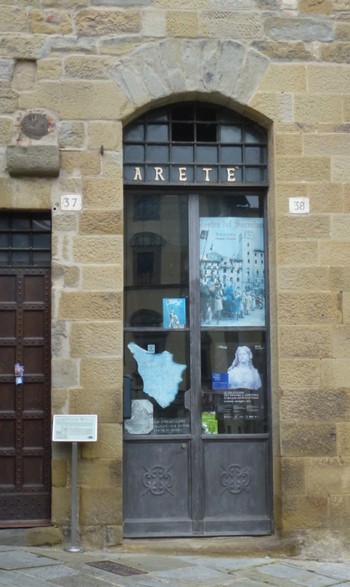
Shop in Arezzo, Piazza Grande
(where Minucci likely had his shop,
precise location is unknown)
|
|
